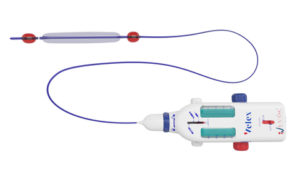
I-Vasc, which has developed and CE marked its percutaneous Velex system to treat chronic venous insufficiency (CVI), has announced that Velex has entered clinical use, with the first two cases performed last week in Milan, Italy, at the Policlinico San Donato Centre.
These first two cases represent the start of the V.A.S.C. postmarket clinical trial, that will be executed in a group of qualified centres, coordinated by Policlinico San Donato, that includes the San Raffaele Hospital in Milan and other international sites.
According to a company press release, Velex is an innovative minimally invasive catheter system which performs an advanced form of sclerotherapy (chemical ablation) based on the empty vein ablation (EVA) concept, invented and developed by Mario Salerno, who is also the founder of I-Vasc and the chairman of the board.
I-Vasc details that the EVA technology allows a fully controlled application of the sclerosant drug in the segment of vein to be treated. Before injection of the drug this segment is emptied from blood and isolated from the rest of the venous system.
“We are proud of having started the clinical use of Velex as per our product roll-out plans” stated Daniele Zanotti, I-Vasc’s CEO, “and having done that at such a qualified centre as San Donato, with an investigator of the experience Paolo Righini and the impressive team of Prof Giovanni Nano. This for us, is only the first step of a market introduction path that will lead Velex to be progressively introduced in the European market first, as it is already CE marked, as well as the US market by pursuing the [US Food and Drug Administration] FDA approval too”.
Paolo Righini, principal investigator of the V.A.S.C. trial, has stated: “We have been following the development of this technology for a while and we were very interested in verifying its clinical performance. Velex is based on a simple and elegant concept that has the potential to make endovascular chemical ablation more effective from every point of view, especially for patients with larger vessels such as the large saphenous veins treated today in this study. These veins would be the most challenging for current sclerotherapy. They would perhaps be alternatively treated with thermal/mechanical ablation, that however, require the use of anaesthesiologic drugs because of considerable intra-procedural discomfort. While only follow-up on all the approximate 30 patients to be enrolled in the study will provide sufficient data for an adequate evaluation, the procedural success and the short-term evidence give us hope for the best.”
“I am thrilled that the EVA technology has been eventually become available to CVI patients,” said Mario Salerno, inventor of the technology, founder of I-Vasc and a vascular surgeon himself. “I have devised this concept after many years of experience with various techniques, especially sclerotherapy, that systematically fall short not only in efficacy, especially for the larger vessels to treat, but sometimes also their safety, difficulty to be used, patients’ compliance, and lastly not to mention the costs for the most recent ones. With the EVA concept I intended to strike a new level of performances that could overcome all these compromises and establish a novel therapeutic paradigm. Only the clinical use will tell us whether we have succeeded, but after the first two cases our expectation has definitely risen”.







